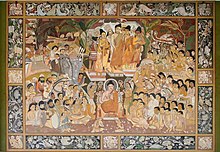File:Ajanta Cave 17, antechamber to the shrine, Adoration of the Buddha (color illustration) with foreigners highlighted.jpg
From Wikimedia Commons, the free media repository
Jump to navigation
Jump to search

Size of this preview: 729 × 600 pixels. Other resolutions: 292 × 240 pixels | 584 × 480 pixels | 934 × 768 pixels | 1,245 × 1,024 pixels | 1,672 × 1,375 pixels.
Original file (1,672 × 1,375 pixels, file size: 551 KB, MIME type: image/jpeg)
File information
Structured data
Captions
Captions
Add a one-line explanation of what this file represents
Summary[edit]
| DescriptionAjanta Cave 17, antechamber to the shrine, Adoration of the Buddha (color illustration) with foreigners highlighted.jpg |
English: Ajanta Cave 17, antechamber to the shrine, Adoration of the Buddha (color illustration) with foreigners highlighted
|
| Date | |
| Source |
Detail and rework of  |
| Author | Yann Forget |
| Attribution (required by the license) InfoField | This file is not in the public domain. Therefore you are requested to use the following next to the image if you reuse this file: © Yann Forget / Wikimedia Commons / CC-BY-SA. If you want other conditions, or have further questions about the terms of licence, please contact me. If you use one of my picture, I appreciate very much if you send me an email. The CC-BY-SA license is incompatible with Facebook's licensing terms. It is not allowed to upload this file to Facebook. |
InfoField | This file is not in the public domain. Therefore you are requested to use the following next to the image if you reuse this file: © Yann Forget / Wikimedia Commons |
Licensing[edit]

|
Permission is granted to copy, distribute and/or modify this document under the terms of the GNU Free Documentation License, Version 1.2 or any later version published by the Free Software Foundation; with no Invariant Sections, no Front-Cover Texts, and no Back-Cover Texts. A copy of the license is included in the section entitled GNU Free Documentation License.http://www.gnu.org/copyleft/fdl.htmlGFDLGNU Free Documentation Licensetruetrue |
File history
Click on a date/time to view the file as it appeared at that time.
| Date/Time | Thumbnail | Dimensions | User | Comment | |
|---|---|---|---|---|---|
| current | 16:08, 30 October 2017 |  | 1,672 × 1,375 (551 KB) | पाटलिपुत्र (talk | contribs) | User created page with UploadWizard |
You cannot overwrite this file.
File usage on Commons
There are no pages that use this file.